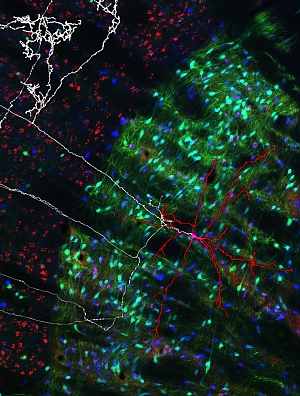 Parasagittal section of the striatum and external globus pallidus (to the left and right, respectively), showing immunofluorescence for parvalbumin (green), preproenkephalin (red), and the pan-neuronal marker HuCD (blue). Prototypic neurons of the globus pallidus express parvalbumin (green/turquoise), whereas arkypallidal neurons instead express preproenkephalin (evident as pink signal). The single arkypallidal neuron in the foreground (soma/dendrites in red, axon in white) exclusively innervates striatum, another hallmark of this novel cell type.
Parasagittal section of the striatum and external globus pallidus (to the left and right, respectively), showing immunofluorescence for parvalbumin (green), preproenkephalin (red), and the pan-neuronal marker HuCD (blue). Prototypic neurons of the globus pallidus express parvalbumin (green/turquoise), whereas arkypallidal neurons instead express preproenkephalin (evident as pink signal). The single arkypallidal neuron in the foreground (soma/dendrites in red, axon in white) exclusively innervates striatum, another hallmark of this novel cell type.Movement difficulties in people with Parkinson’s disease arise because of the disturbed electrical activity of nerve cells in the brain. Excessive rhythmic activities called ‘beta oscillations’ are one key disturbance. Research carried out at the Unit has given new insights into why and how these beta oscillations might emerge throughout the Parkinsonian brain. By matching the electrical activity of individual nerve cells to their connections, members of the Magill group have discovered that two different types of cell in a brain area called the external globus pallidus (GPe) could perform a division of labour to control many other areas important for movement. In their recently published paper, the team also reveal a novel type of GPe cell that provides massive and specific connections to the striatum, a brain area that is of central importance in Parkinson’s. Because these remarkable GPe cells are positioned to cast wide nets of influence over their targets, they were termed “arkypallidal neurons” (from ancient Greek αρκυς [arkys] for ‘hunter’s net’). Dr. Magill commented, “Exposing the striking diversity of GPe cells is a game changer for the field. The challenge ahead now is to explain the building blocks and necessity of this diversity”.
This research was highlighted in 'Neuroanatomy: Out with the old (model)' by Leonie Welberg, Nature Reviews Neuroscience 13, 518-519 (August 2012).